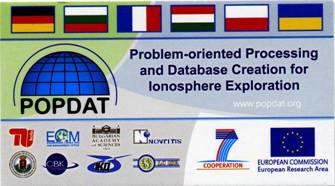
"The evidence suggests we're now crossing the boundary in terms of technology readiness" Stuart Eves, SSTL

Society of Geomagnetism and Earth, Planetary and Space Sciences (SGEPSS) Award
Ionosphere Observation Satellites for Earthquake Precursor by National Defense Academy

Seventh Framework Programme of the European Union Project “Problem-oriented Processing and Database Creation for Ionosphere Exploration” (POPDAT) started on June 1, 2011. Lviv Center of Institute for Space Research is an initiator of the Project together with Space Research Institute (Kyiv). Efforts of eight organizations from Bulgaria, France, Germany, Hungary, Poland and Ukraine are joined in the Project.
About the IGMASS Project promotion in the Year of half-century Anniversary of the First Manned Flight
Mr. Sergey Chercass (Russian Federation)
Precursors of major earthquakes and evaluating opportunities of its using in seismic forecasting
The Institute for Radio Astronomy (NAFRI) of PUCP leads the research project called Peru-Magneto , who seeks to study what is the relationship between electromagnetic phenomena in the subsurface and seismic activity.* Colloquium Peru - Magneto | videos (PUCP)
* Telefonica and Catholic University join forces to develop earthquake warning system (Businessempresarial)
地震の予知が宇宙からできないかと世界的な関心が高まっている。現象の把握から予測につながる研究をしていきたい。
Masashi Kamogawa: Project of Micro-Satellite Constellation for Earthquake Precursor Study
Vu Bui: Nano-satellite constellation collecting global pre-earthquake signals for space-borne early earthquake detection
Microsatellite Ionospheric Network in Orbit In tribute to Mino Freund
Category 1 - 2nd place: Project of Micro-Satellite Constellation for Earthquake Precursor Study
Following a successful launch of the first Karat science satellite in July 2012, Russian space agency, Roskosmos, gave green light to use of the same spacecraft as a basis for a whole new series of scientific missions.
During the next phase of development, the Karat satellite bus woud provide a platform for a total of four missions greately expanding the horizons of the Russian science:MKA-FKI (PN2) Relek MKA-FKI (PN3) Konus-M (372A353) MKA-FKI (PN4) Strannik MKA-FKI (PN5) ARKA
Society of Geomagnetism and Earth, Planetary and Space Sciences (SGEPSS) Award and Review Committee Chief Special Award
CKUSAT (Cheng Kung University SATellite) by National Cheng Kung University [pdf]
○ 世界の防災・減災のための新たな構想として地震予知の可能性調査のための「電離層観測衛星群」を提案する。
・宇宙を利用した地震予知研究を推進すべき。
・宇宙太陽光シールドの設置やGPSを使った地震直前予知など成功の確率は低くてもハイリスクハイリターンの研究にも取り組む余裕が必要である。
・ASEAN衛星を打ち出すべき。また、APRSAFの協力枠組みにおいて、アジアの国々の衛星打ち上げ機会を提供すべき。連携の一例 としては、大地震前の電離圏擾乱の把握による大地震予測研究のための小型衛星コンステレーションなどがあげられる。
